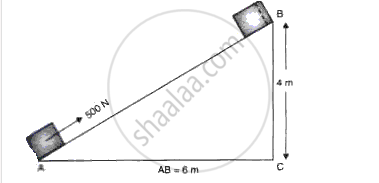Advertisements
Advertisements
Question
Solution
K.E, K = `1/2 mv²
if speed is incresed four times
K.E,K' = `1/2` m(4v)²
or K' = 16 x `1/2` mv² = 16K
thus K.E becomes sisxteen times
APPEARS IN
RELATED QUESTIONS
A force of 7 N acts on an object. The displacement is, say 8 m, in the direction of the force (see the given figure). Let us take it that the force acts on the object through the displacement. What is the work done in this case?

Name the forms of energy which a wound-up watch spring possesses.
The power of a motor is 40 kW. At what speed can the motor raise a load of 20,000 N?
A vessel containing 50 kg of water is placed at a height 15 m above the ground. Assuming the gravitational potential energy at ground to be zero, what will be the gravitational potential energy of water in the vessel? (g = 10 m s-2)
Find the kinetic energy of a body of mass 1 kg moving with a uniform velocity of 10 m s-1.
State the energy transformation on the following:
Electricity is obtained from solar energy.
The work done on an object does not depend on the :
A uniform circular motion is an accelerated motion. Justify it.
A block of mass 20 kg is pulled up a slope (fig.12) with a constant speed by applying a force of 500 N parallel to the slope. A and B are initial and final positions of the block.
(a) Calculate the work done by the force in moving the block from A and B.
(b) Calculate the potential energy gained by the block.

(i) A 200g ball is thrown vertically upward with an initial velocity of 30 ms-1. Draw a velocity-time graph for the motion of ball.
(ii) How long will the ball take to reach the highest point?
(iii) What will be the kinetic energy of ball, when it returns to the starting point, neglecting the air resistance?
(iv) What will be the potential energy of ball at highest point?
A force is applied on a body of mass 20 kg moving with a velocity of 40 ms−1. The body attains a velocity of 50 ms−1 in 2 seconds. Calculate the work done by the body.
A coolie is pushing a box weighing 1500 N up an inclined plane 7.5 m long on to a platform, 2.5 m above the ground.
(i) Calculate the mechanical advantage of the inclined plane. (ii) Calculate the effort applied by the coolie.
(iii) In actual practice, the coolie needs to apply more effort than what is calculated. Give one reason why you think the coolie needs to apply more effort.
A girl of mass 40 kg runs a height of 80 stairs, each 25 cm high with a load of 20 kg on her head in 25 sec. If g is 10 m/s2, find:
(i) Gravitational force acting on the girl.
(ii) Work done by her.
(iii) Useful work done by her.
(iv) Her power in watt.
Look at the activity below. Reason out whether or not work is done in the light of your understanding of the term ‘work’.
Food grains are getting dried in the sun.
Work done by this force at any instant is ______.
